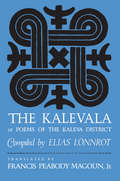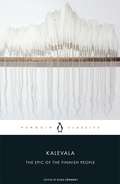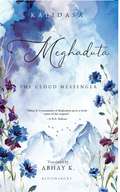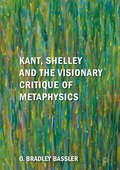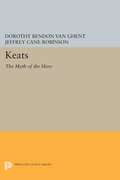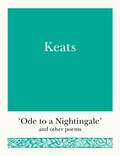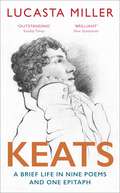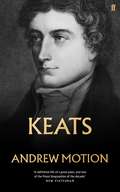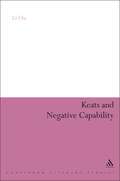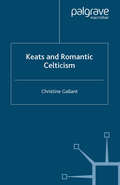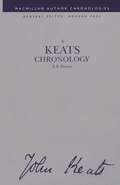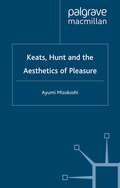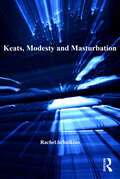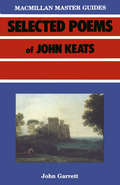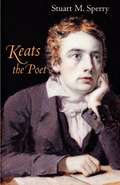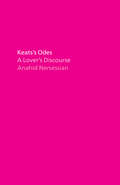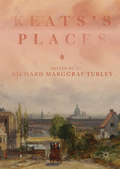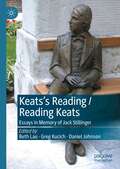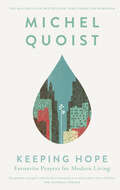- Table View
- List View
The Kalevala: Or, Poems of the Kaleva District
by Elias LönnrotThe national folk epic of Finland is here presented in an English translation that is both scholarly and eminently readable. To avoid the imprecision and metrical monotony of earlier verse translations, Francis Magoun has used prose, printed line for line as in the original so that repetitions, parallelisms, and variations are readily apparent. The lyrical passages and poetic images, the wry humor, the tall-tale extravagance, and the homely realism of the Kalevala come through with extraordinary effectiveness.
Kalevala: The Epic of the Finnish People
by Elias Lönnrot'One of the great mythic poems of Europe' The New York TimesSharing its title with the poetic name for Finland - 'the land of heroes' - Kalevala is the soaring epic poem of its people, a work rich in magic and myth which tells the story of a nation through the ages from the dawn of creation. Sung by rural Finns since prehistoric times, and formally compiled by Elias Lönnrot in the nineteenth century, it is a landmark of Finnish culture and played a vital role in galvanizing its national identity in the decades leading to independence. Its themes, however, reach beyond borders and search the heart of human existence.Translated with an Introduction by Eino Friberg
Kalidasa: Meghduta The Cloud Messenger
by Abhay K.Meghaduta or The Cloud Messenger is a masterpiece of Sanskrit literature, written by Kalidasa some 1500 years ago. This breathtaking poem of 111 stanzas is about a Yaksha, who is banished for a year to central India for neglecting his duties by Kubera-the Lord of Wealth, from his abode at the fabled city of Alaka near Mount Kailasa. The Yaksha exhorts a passing cloud to carry his message across to his beloved in the Himalayas. The cloud is assisted by sylphs, nymphs, eight-legged animals, the wish fulfilling trees, drums, celestial elephants, birds, rare flowers, trees and rivers during his journey.
Kant, Shelley and the Visionary Critique of Metaphysics
by O. Bradley BasslerThis book addresses the philosophy of Kant and the poetry of Shelley as historical starting points for a new way of thinking in the modern age. Fusing together critical philosophy and visionary poetry, Bassler develops the notion of visionary critique, or paraphysics, as a model for future philosophical endeavor. This philosophical practice is rooted in the concept of the indefinite power associated with the sublime in both Kant and Shelley’s work, to which the notion of the parafinite or indefinitely large is extended in this book.
Kant, Shelley and the Visionary Critique of Metaphysics
by O. Bradley BasslerThis book addresses the philosophy of Kant and the poetry of Shelley as historical starting points for a new way of thinking in the modern age. Fusing together critical philosophy and visionary poetry, Bassler develops the notion of visionary critique, or paraphysics, as a model for future philosophical endeavor. This philosophical practice is rooted in the concept of the indefinite power associated with the sublime in both Kant and Shelley’s work, to which the notion of the parafinite or indefinitely large is extended in this book.
Keats: The Myth of the Hero
by Dorothy Bendon Van Ghent Jeffrey Cane RobinsonFocusing in a new and thoroughgoing way on Keats's widely discussed interest in Greek myth, Professor Van Ghent finds the underlying coherence in both his poetry and his letters to be archetypes of the hero and his double"--pervasive myths of creation and generation reflected in his poetics of desire.Originally published in 1983.The Princeton Legacy Library uses the latest print-on-demand technology to again make available previously out-of-print books from the distinguished backlist of Princeton University Press. These editions preserve the original texts of these important books while presenting them in durable paperback and hardcover editions. The goal of the Princeton Legacy Library is to vastly increase access to the rich scholarly heritage found in the thousands of books published by Princeton University Press since its founding in 1905.
Keats: 'Ode to a Nightingale' and Other Poems (Pocket Poets #2)
by John KeatsArguably the greatest of all the English Romantic poets, John Keats left behind him an astonishingly large body of work almost as remarkable for its maturity as for its beauty.Whether in longer narrative works like ‘The Eve of St Agnes’, or in such sonnets as ‘On First Looking Into Chapman’s Homer’, or in magnificent odes like those ‘To a Nightingale’ and ‘To Autumn’, his verse resonates with lyricism and with sensuous imagery, however melancholy his tone or his subject. His finest poems are among the greatest in the language; almost all of them strike a chord in the heart of even the most jaded reader.This compact selection includes many of Keats’s greatest shorter poems, as well as extracts from his longer works.
Keats: A Brief Life in Nine Poems and One Epitaph
by Lucasta Miller*A BOOK TO LOOK FORWARD TO IN 2021 IN THE TIMES, FINANCIAL TIMES, DAILY MAIL, SUNDAY TIMES AND GUARDIAN*The epitaph John Keats composed for his own gravestone - 'Here lies one whose name was writ in water' - seemingly damned him to oblivion. When he died at the age of twenty-five, having taken a battering from the conservative press, few critics imagined he would be considered one of the great English poets two hundred years later, though he himself had an inkling.In this brief life, Lucasta Miller takes Keats's best-known poems - the ones you are most likely to have read - and excavates their backstories. In doing so, she resurrects the real Keats: a lower-middle-class outsider from a tragic and dysfunctional family, whose extraordinary energy and love of language allowed him to pummel his way into the heart of English literature; a freethinker and a liberal at a time of repression; a human being who delighted in the sensation of the moment; but a complex individual, not the ethereal figure of his posthumous myth.Combining close-up readings of his writings with the story of his brief but teeming existence, Lucasta Miller shows us how Keats made his poetry, and explains why it retains its vertiginous originality and continues to speak to us across the generations.
Keats: Selected By Andrew Motion (Faber Poetry Ser.)
by Sir Andrew MotionKeats is the first major biography of this tragic hero of romanticism for some thirty years, and it differs from its predecessors in important respects. The outline of the story is well known - has become, in fact, the stuff of legend: the archetypal life of the tortured genius, critically spurned and dying young.What Andrew Motion brings to bear on the subject is a deep understanding of how Keats fitted into the intellectual and political life of his time. Important friendships with such anti-establishment figures as William Hazlitt and Leigh Hunt are given their full due, and the closeness of his own spirit, as expressed in his poems, to the ferment all around is made clear. Many significant new facts about Keats's schooldays and medical training, in particular, enrich the picture. Keats emerges as a more political figure than he is usually portrayed, but his personal sufferings, too, come into closer focus. Most importantly, Andrew Motion - himself a distinguished poet and former poet laureate - demonstrates how the poems continue to exert their power. 'A definitive life of a great poet, and one of the finest biographies of the decade.' New Statesman
Keats and Negative Capability (Continuum Literary Studies)
by Li Ou"Negative capability", the term John Keats used only once in a letter to his brothers, is a well-known but surprisingly unexplored concept in literary criticism and aesthetics. This book is the first book-length study of this central concept in seventy years. As well as clarifying the meaning of the term and giving an anatomy of its key components, the book gives a full account of the history of this idea. It traces the narrative of how the phrase first became known and gradually gained currency, and explores its primary sources in earlier writers, principally Shakespeare and William Hazlitt, and its chief Modernist successors, W. B. Yeats and T. S. Eliot. Meanwhile, the term is also applied to Keats's own poetry, which manifests the evolution of the idea in Keats's poetic practice. Many of the comparative readings of the relevant texts, including King Lear, illuminate the interconnections between these major writers. The book is an original and significant piece of scholarship on this celebrated concept.
Keats and Negative Capability (Continuum Literary Studies)
by Li Ou"Negative capability", the term John Keats used only once in a letter to his brothers, is a well-known but surprisingly unexplored concept in literary criticism and aesthetics. This book is the first book-length study of this central concept in seventy years. As well as clarifying the meaning of the term and giving an anatomy of its key components, the book gives a full account of the history of this idea. It traces the narrative of how the phrase first became known and gradually gained currency, and explores its primary sources in earlier writers, principally Shakespeare and William Hazlitt, and its chief Modernist successors, W. B. Yeats and T. S. Eliot. Meanwhile, the term is also applied to Keats's own poetry, which manifests the evolution of the idea in Keats's poetic practice. Many of the comparative readings of the relevant texts, including King Lear, illuminate the interconnections between these major writers. The book is an original and significant piece of scholarship on this celebrated concept.
Keats and Romantic Celticism
by C. GallantThe Celtic Revival began more than a century before Yeats and the Irish Literary Renaissance. Keats and Romantic Celtism is the first book to consider the pervasive influence of period Celticism upon Keats's work, from the Druidism that underlies his unfinished epics to the Celtic-derived folklore that his poetry draws upon. Christine Gallant shows that more than two hundred and fifty traditional folklore motifs of the faerie fill his major poems, as well as minor epistolary ones that have been critically neglected.
A Keats Chronology (Author Chronologies Series)
by F B PinionThis fully detailed chronology makes the best use of Keats's letters to indicate his poetic aims and achievements. It is supplemented by a valuable introduction and interestingly informative sketches of more than thirty persons of importance in his life. With maps and a bibliography, this work is not only an intensely intimate biography but also an exceptionally useful reference book for students and scholars.
Keats, Hunt and the Aesthetics of Pleasure (Romanticism in Perspective:Texts, Cultures, Histories)
by Ayumi MizukoshiThis book tackles the age-old interpretative problem of 'pleasure' in Keat's poetry by placing him in the context of the liberal, leisured and luxurious culture of Hunt's circle. Challenging the standard narrative which attribute Keat's astonishing poetic development to his separation from Hunt, the author cogently argues that Keats, profoundly imbued with Hunt's bourgeois ethic and aesthetic, remained a poet of sensuous pleasure through to the end of his short career.
Keats, Modesty and Masturbation
by Rachel SchulkinsExamining John Keats’s reworking of the romance genre, Rachel Schulkins argues that he is responding to and critiquing the ideals of feminine modesty and asexual femininity advocated in the early nineteenth century. Through close readings of Isabella; or the Pot of Basil, The Eve of St. Agnes, Lamia and ’La Belle Dame sans Merci,’ Schulkins offers a re-evaluation of Keats and his poetry designed to demonstrate that Keats’s sexual imagery counters conservative morality by encoding taboo desires and the pleasures of masturbation. In so doing, Keats presents a version of female sexuality that undermines the conventional notion of the asexual female. Schulkins engages with feminist criticism that largely views Keats as a misogynist poet who is threatened by the female’s overwhelming sexual and creative presence. Such criticism, Schulkins shows, tends towards a problematic identification between poet and protagonist, with the text seen as a direct rendering of authorial ideology. Such an interpretation neither distinguishes between author, protagonist, text, social norms and cultural history nor recognises the socio-sexual and political undertones embedded in Keats’s rendering of the female. Ultimately, Schulkins’s book reveals how Keats’s sexual politics and his refutation of the asexual female model fed the design, plot and vocabulary of his romances.
Keats, Modesty and Masturbation
by Rachel SchulkinsExamining John Keats’s reworking of the romance genre, Rachel Schulkins argues that he is responding to and critiquing the ideals of feminine modesty and asexual femininity advocated in the early nineteenth century. Through close readings of Isabella; or the Pot of Basil, The Eve of St. Agnes, Lamia and ’La Belle Dame sans Merci,’ Schulkins offers a re-evaluation of Keats and his poetry designed to demonstrate that Keats’s sexual imagery counters conservative morality by encoding taboo desires and the pleasures of masturbation. In so doing, Keats presents a version of female sexuality that undermines the conventional notion of the asexual female. Schulkins engages with feminist criticism that largely views Keats as a misogynist poet who is threatened by the female’s overwhelming sexual and creative presence. Such criticism, Schulkins shows, tends towards a problematic identification between poet and protagonist, with the text seen as a direct rendering of authorial ideology. Such an interpretation neither distinguishes between author, protagonist, text, social norms and cultural history nor recognises the socio-sexual and political undertones embedded in Keats’s rendering of the female. Ultimately, Schulkins’s book reveals how Keats’s sexual politics and his refutation of the asexual female model fed the design, plot and vocabulary of his romances.
Keats the Poet
by Stuart M. SperryKeats the Poet was first published in 1973, just as the crest of all the New-Critical exegeses had passed, leaving the critical literature with a wealth of fine readings, but without a real organizing program within which to view them. Stuart Sperry established such a frame of reference. Further, he did so with such prescience that even the most radical deconstructive or new historical approaches to Keats today must bear witness to their inception in Sperry's emphasis on, and subtle demonstration of, the centrality of "indeterminacy' in the poet. Now available in paperback for the first time, this work will enlighten a new generation of readers.
Keats’s Negative Capability: New Origins and Afterlives (Romantic Reconfigurations: Studies in Literature and Culture 1780-1850 #6)
In late December 1817, when attempting to name “what quality went to form a Man of Achievement especially in Literature,” John Keats coined the term “negative capability,” which he glossed as “being in uncertainties, Mysteries, doubts, without any irritable reaching after fact & reason.” Since then negative capability has continued to shape assessments of and responses to Keats’s work, while also surfacing in other contexts ranging from contemporary poetry to punk rock. The essays collected in this volume, taken as a whole, account for some of the history of negative capability, and propose new models and directions for its future in scholarly and popular discourse. The book does not propose a particular understanding of negative capability from among the many options (radical empathy, annihilation of self, philosophical skepticism, celebration of ambiguity) as the final word on the topic; rather, the book accounts for the multidimensionality of negative capability. Essays treat negative capability’s relation to topics including the Christmas pantomime, psychoanalysis, Zen Buddhism, nineteenth-century medicine, and Philip Pullman’s His Dark Materials trilogy. Describing the “poetical Character” Keats notes that “it enjoys light and shade; it lives in gusto, be it foul or fair, high or low, rich or poor, mean or elevated.” This book, too, revels in such multiplicity.
Keats's Odes: A Lover's Discourse
by Anahid Nersessian“When I say this book is a love story, I mean it is about things that cannot be gotten over—like this world, and some of the people in it.” In 1819, the poet John Keats wrote six poems that would become known as the Great Odes. Some of them—“Ode to a Nightingale,” “To Autumn”—are among the most celebrated poems in the English language. Anahid Nersessian here collects and elucidates each of the odes and offers a meditative, personal essay in response to each, revealing why these poems still have so much to say to us, especially in a time of ongoing political crisis. Her Keats is an unflinching antagonist of modern life—of capitalism, of the British Empire, of the destruction of the planet—as well as a passionate idealist for whom every poem is a love poem. The book emerges from Nersessian’s lifelong attachment to Keats’s poetry; but more, it “is a love story: between me and Keats, and not just Keats.” Drawing on experiences from her own life, Nersessian celebrates Keats even as she grieves him and counts her own losses—and Nersessian, like Keats, has a passionate awareness of the reality of human suffering, but also a willingness to explore the possibility that the world, at least, could still be saved. Intimate and speculative, this brilliant mix of the poetic and the personal will find its home among the numerous fans of Keats’s enduring work.
Keats's Places
by Richard Marggraf TurleyAs the essays in this volume reveal, Keats’s places could be comforting, familiar, grounding sites, but they were also shifting, uncanny, paradoxical spaces where the geographical comes into tension with the familial, the touristic with the medical, the metropolitan with the archipelagic. Collectively, the chapters in Keats’s Places range from the claustrophobic stands of Guy’s Hospital operating theatre to the boneshaking interior of the Southampton mail coach; from Highland crags to Hampstead Heath; from crowded city interiors to leafy suburban lanes. Offering new insights into the complex registrations of place and the poetic imagination, the contributors to this book explore how the significant places in John Keats’s life helped to shape an authorial identity.
Keats's Places
by Richard Marggraf TurleyAs the essays in this volume reveal, Keats’s places could be comforting, familiar, grounding sites, but they were also shifting, uncanny, paradoxical spaces where the geographical comes into tension with the familial, the touristic with the medical, the metropolitan with the archipelagic. Collectively, the chapters in Keats’s Places range from the claustrophobic stands of Guy’s Hospital operating theatre to the boneshaking interior of the Southampton mail coach; from Highland crags to Hampstead Heath; from crowded city interiors to leafy suburban lanes. Offering new insights into the complex registrations of place and the poetic imagination, the contributors to this book explore how the significant places in John Keats’s life helped to shape an authorial identity.
Keats’s Reading / Reading Keats: Essays in Memory of Jack Stillinger
by Daniel Johnson Beth Lau Greg KucichThis book explores John Keats’s reading practices and intertextual dialogues with other writers. It also examines later writers’ engagements with Keats’s poetry. Finally, the book honors the distinguished Keats scholar Jack Stillinger and includes an essay surveying his career as well as a bibliography of his major publications. The first section of the volume, “Theorizing Keats’s Reading,” contains four essays that identify major patterns in the poet’s reading habits and responses to other works. The next section, “Keats’s Reading,” consists of six essays that examine Keats’s work in relation to specific earlier authors and texts. The four essays in the third section, “Reading Keats,” consider how Keats’s poetry influenced the work of later writers and became embedded in British and American literary traditions. The final section of the book, “Contemporary Poetic Responses,” features three scholar-poets who, in poetry and/or prose commentary, discuss and exemplify Keats’s impact on their work.
Keeping Hope – Favourite Prayers for Modern Living: Selected Inspirational Prayers from World-Renowned Theologian Michel Quoist
by Michel QuoistPrayers from Michel Quoist, the multi-million bestselling publishing phenomenon, available for the first time as an ebookThe prayers of Michel Quoist are not prayers in the usual sense, but meditations on life. Beginning with seemingly ordinary events, suddenly the light of faith is thrown on some part of our ordinary, everyday existence. Set against the roads, offices and high-rise buildings that frame our modern world, this collection of practical prayers and meditations penetrates the heart of human experience.Rooted in the modern world and in the thoughts and feelings that define our everyday experience, they celebrate our small victories and offer support as we struggle with universal themes – among them self-acceptance, loneliness, despair, ageing, loss and grief. Quoist’s prayers encourage us to celebrate and harness the tools and talents we have at our disposal to make the best of what we have. Editorial Reviews'His greatest strength is that he shows humanity as an asset rather than a liability.' The Catholic Herald'To those long familiar with Quoist’s writing – and those who are new to him – this book may prove a landmark in the spiritual lives of many in a new century and a new millennium.' Peter Costello, The Irish Catholic'Michel Quoist sold millions of books in 27 different languages because of that ability to make prayer possible for the less contemplative among us.' Fr Brian D' Arcy, Sunday World
Keeping the Ancient Way: Aspects of the Life and Work of Henry Vaughan (1621-1695) (English Association Monographs: English at the Interface #7)
by Robert WilcherWritten by one of the editors of the new complete works of Henry Vaughan, Keeping the Ancient Way is the first book-length study of the poet by a single author for twenty years. It deals with a number of key topics that are central to the understanding and appreciation of this major seventeenth-century writer. These include his debt to the hermetic philosophy espoused by his twin brother (the alchemist, Thomas Vaughan); his royalist allegiance in the Civil War; his loyalty to the outlawed Church of England during the Interregnum; the unusual degree of intertextuality in his poetry (especially with the Scriptures and the devotional lyrics of George Herbert); and his literary treatment of the natural world (which has been variously interpreted from Christian, proto-Romantic, and ecological perspectives). Each of the chapters is self-contained and places its topic in relation to past and current critical debates, but the book is organized so that the biographical, intellectual, and political focus of Part One informs the discussion of poetic craftsmanship in Part Two. A wealth of historical information and close critical readings provide an accessible introduction to the poet and his period for students and general readers alike. The up-to-date scholarship will also be of interest to specialists in the literature and history of the Civil War and Interregnum.
